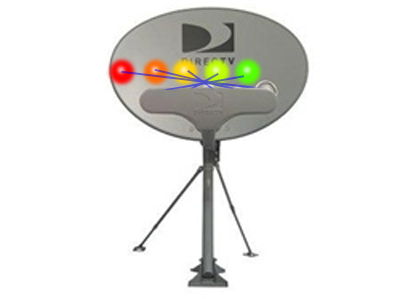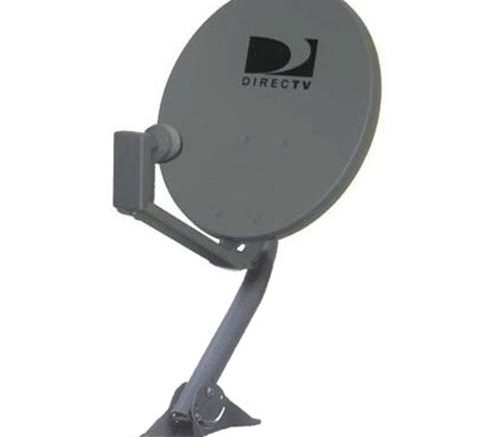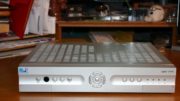It’s not a coincidence that both DIRECTV and DISH have satellite antennas that are about 36″ wide. There’s a FCC rule called OTARD that says an HOA can’t stop you from putting up an antenna if it’s smaller than one meter (39.37″) in any direction. Both US satellite providers have kept this rule in mind when designing their equipment. After all, it wouldn’t help business if HOA’s around the country didn’t allow people to put up satellite dishes, right?
But, is it possible that today’s satellite dishes could get smaller? Technology has advanced a lot since the late 2000s when today’s satellite dishes were first released to the public. You would think that today it would be possible to make much smaller devices, right? In order to understand where we are now, we first have to understand why dishes got bigger in the first place. I touch on this subject a bit in this article, but it’s worth going a little further.
The original dream: 18″ or smaller
Back in the days before DIRECTV and DISH existed, my tech buddies and I used to talk about the dream of the “set-top dish.” This would have been a satellite antenna about 12″ in diameter that was capable of being placed inside. That dream never came to pass for two reasons. First is that satellite signals are so weak that they can’t make it into your house. The antenna simply has to be outside. The second is that the aiming needs to be so precise that you would never want the dish to be anywhere you could jostle it.
The compromise that actually worked was a dish 18″ in diameter. Satellite services all around the world use round dishes with very similar characteristics, and both DIRECTV and DISH used them too, at first. They’re small enough to mount easily and can be aimed even by your average homeowner. That worked well, until satellite TV really began to “take off.”
Why dishes got bigger
By the mid-2000s, DIRECTV and DISH were in a pair of races. The first was to see who could provide local channel service to 90% of the country. The second was to see who could put up the most HD channels. That meant expanding the satellite fleet so it could handle thousands of locals and hundreds of HD channels. Those HD channels took up to four times the satellite capacity as older SD channels.
Both companies responded by launching additional satellites. However, there are only so many satellites that can sit in one point in space. They found themselves putting satellites in many different orbital slots, and that meant in order to receive all of them, you needed to make some sort of change.
DISH initially let customers put up two round dishes, while DIRECTV almost immediately came up with dishes that pointed at two satellites at the same time. The “one dish” solution is the one that customers favored.
The problem with pointing at two locations at once is that you need to focus everything on one point, and when signals are coming from different directions a simple round dish won’t do. You need a dish that is, in essence, multiple round dishes stitched together. The result is an oval-shaped dish.

This graphic I made many years ago illustrates the point. At the time, DIRECTV had five primary satellite locations. Each one hit at a different point of the dish, and was focused on a different point on the front of the dish. DISH did something similar as well.
It got to the point where DIRECTV and DISH both operated satellites at seven locations. For DIRECTV, you needed to see five at once for most channels while the other two were used for international channels. DISH used two different sets of three satellites plus one for international, so aiming was a little easier.
And then things actually got simpler
Operating a satellite is expensive. It costs a lot to put the thing up there, and it costs a lot to keep monitoring it. Having multiple satellite locations is great, but it’s even better if you can use larger satellites and fewer locations. Both DIRECTV and DISH spent the 2010s and early 2020s simplifying their fleets. DIRECTV was able to take three satellite locations out of service, the ones used for international programming. They did this by launching massively large satellites that used something called the reverse band for extra channel capacity. The company is also working now to eliminate a fourth satellite location so that the only ones left are a small constellation at 99, 101, and 103 West longitude.
DISH simplified its fleet by changing the way its signals are encoded. They were able to eliminate two satellites, one from their eastern “arc” and one from their western “arc.” This means no matter where you are in the country you really only need to see two satellite locations unless you subscribe to an international package. If you’re on the east, you point at satellites at 61 and 77 degrees, while westerners point at satellites at 110 and 119 degrees.
So if things are simpler, why aren’t the dishes smaller?
There’s no doubt in my mind that DIRECTV dishes could get much smaller. All three satellites are now in a spread of only four degrees of the sky. That says to me that it would be very possible to have a satellite dish 18×24 inches in size. With DISH it’s a little more complex. DISH’s Western Arc still has a spread of nine degrees, while the Eastern Arc has the same spread of 16 degrees that it always had. So, it wouldn’t be possible to make Eastern Arc dishes smaller, and Western Arc dishes might not get smaller enough to notice.
The truth is, though, those dishes probably won’t get smaller. And there’s a simple reason for it: it just won’t make a difference to enough people. It would take a lot of time and cost to engineer a smaller dish, and it probably wouldn’t result in anyone being any happier with their satellite service. Those who think the dish is ugly would probably still think it’s ugly if it got a little smaller. Re-engineering the dishes to be smaller would just please those few people (like myself) who get a particular kick out of engineering things so they’re perfect. Unfortunately there aren’t enough of us for it to probably make economic sense.





